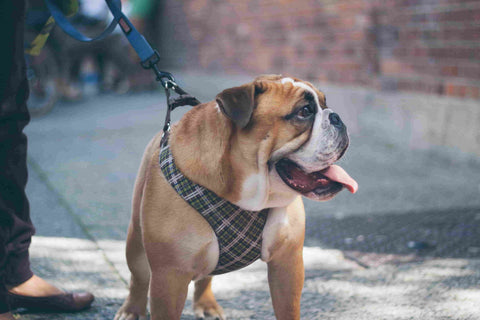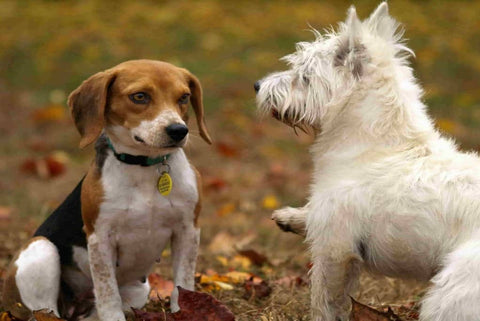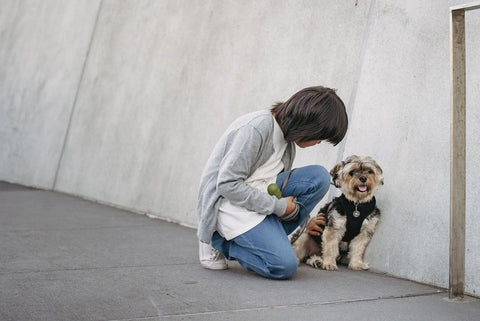Dog Collars Aren’t Safe for Puppies – Here’s Why
If you're a new dog owner, one of the first things you'll want to purchase is a stylish dog collar. However, veterinarians, trainers, and experienced dog owners warn that collars are harmful to puppies and should be avoided to avoid trauma, suffocation, infection, or injury, among other things.
"Are collars harmful to puppies?" This guide will answer this question, explain the main risks of puppies wearing collars, and introduce a safe alternative to collars for puppies.
Risks of Puppies Wearing a Collar
Puppies wearing collars are at risk for a variety of issues. For the following reasons, it's critical to take precautions (or, better yet, avoid using) a collar for a puppy in the first place.
Strangulation
This occurs when puppies' heads become lodged between the links of their dog collars. This can occur if the puppy jumps up and gets its head stuck, or if the puppy attempts to escape from an overly tight collar. The neck of a puppy can become twisted, resulting in strangulation. Strangulation symptoms include difficulty breathing, lethargy, and redness or swelling at the base of the neck.
Puppies are particularly vulnerable to strangulation due to their shorter necks than adult dogs. Additionally, puppies should not be left alone with dog collars. Even better, opt for a safer alternative, such as a harness.
Limb & Mouth Injuries
Using a dog collar on a puppy increases the risk of injury to their limbs or mouth. Puppies can get sores on their paws as well. Another possibility is that their limbs became entangled as a result of collars that were too big for their tiny bodies. Even if you take precautions, choosing a safer option than the collar can help ensure your puppy's safety. To avoid untoward accidents, a harness is a smarter choice.
Skin Irritation & Hair Matting
Dog collars can irritate the skin and cause hair matting. As a result, it's best to avoid them altogether when it comes to puppies. The metal hardware on the collar that comes into contact with the dog's skin, as well as the pressure of the collar around the dog's neck, can cause skin irritation. This pressure can also lead to the formation of matted hair, which can be difficult to remove and can lead to skin sores.
Neck Injuries
Dog collars can also result in neck injuries in puppies. Dog collars can put too much pressure on a puppy's delicate neck, leading to pain and even permanent damage. In some cases, the collar can even choke the puppy.
There are many alternatives to dog collars that are safe and effective, and puppy parents should always consult their veterinarian to find the best option for their pup.
Spinal Problems & Orthopedic Diseases
Several orthopedic diseases can affect dogs, including hip dysplasia, patellar luxation, and intervertebral disc disease (IVDD).
Hip dysplasia is one of the most common orthopedic diseases in dogs. It occurs when the hip socket is not formed properly, resulting in arthritis and difficulty walking. Patellar luxation is another common orthopedic condition in which the kneecap pops out of place. Intervertebral disc disease (IVDD) is the most serious orthopedic condition, in which the discs between the vertebrae become compressed, resulting in spinal problems.
One of the most critical things you can do for your furry companion is to relieve pressure on the neck and back by switching to a harness rather than a collar. Utilizing harnesses rather than neck collars, which are harmful to dogs, can help reduce your dog's risk of developing these spinal problems.
Easy to Escape
Dogs with ill-fitting collars have an easier time escaping. The collar is not secure enough to stay on the dog's head and easily slips off. If your puppy is constantly escaping from its collar, it is critical to obtain a better-fitting harness that is easily adjustable as a substitute. A properly fitted harness is snug enough around the head that it cannot easily slip off. At the same time, it is not too restrictive.
General Pain & Discomfort
Collars for puppies can cause a great deal of general pain and discomfort. They are frequently too tight, restricting the dog's movement and making him uncomfortable. Additionally, the collar's buckle may rub against the dog's neck, causing irritation.
Avoid using puppy collars in favor of a more comfortable alternative, such as a harness. Harnesses are designed to evenly distribute pressure across the dog's body, thereby avoiding unnecessary pain or discomfort.
Which Breeds Should ALWAYS Avoid Wearing Collars?
Certain dog breeds, such as toy breeds and brachycephalic breeds, should avoid wearing collars. Examples of toy breeds include:
- Chihuahuas
- Chinese Crested
- Italian Greyhound
- Maltese
- Toy Poodle
- Yorkshire Terrier
Toy breeds such as Poodles, Yorkies, and Chihuahuas are prone to spinal injuries when their collars are jerked around. Their spines are weak in comparison to those of larger breeds. Brachycephalic breeds have short muzzles and flat faces, which can cause breathing difficulties, which are exacerbated when the dog is wearing a collar. Examples of brachycephalic breeds include:
- Bulldogs
- French Bulldogs
- Boston Terriers
- Pugs
- Boxers
Why Harnesses Are Safer for Puppies
When it comes to collars versus harnesses, the harness always wins. Harnesses are more adjustable than collars, which means they can be adjusted to fit any puppy, regardless of size. Similarly, they are made of breathable material that is nearly seamless when worn, making them more comfortable for puppies than stiff or scratchy collars.
Harnesses also evenly distribute the pressure applied by the taut leash, preventing any point on the puppy's neck from experiencing excessive pressure; it is for these reasons that collars are dangerous for puppies.
As to convenience, harnesses are better than collars. Finally, harnesses are more functional and safe for use. With the reflective straps, you can use them at night and easily lift your puppy when needed.
What Harness Is Best for a Puppy?
Now that we've established the answer to the question, "Are collars good or bad for puppies?" here are some considerations when selecting the proper harness for your precious furbaby:
- Safe design should be a priority, as it can have an effect on your puppies posture and comfort. Multiple-strap harnesses evenly distribute pressure and are less likely to cause choking or other discomfort. To ensure comfort, look for a harness that includes padding around the neck and chest. Additionally, a properly fitted harness prevents your puppy from escaping or becoming tangled in it.
- Durable & breathable. Harnesses made of durable and breathable material help prevent skin irritations, hair matting, and tangling. Harnesses that are not constructed from durable and breathable materials can cause skin irritation, matting, and tangling of the hair.
- Ease of use. Simultaneously, ease of use benefits your puppy and you, the fur parent. Consider purchasing a harness that features easily adjustable straps and quick-release buckles. This way, you'll be able to quickly get set up and out the door.
- Adjustable straps are helpful to achieve the best fit for your puppy. A snug fit is necessary to ensure the safety of your pet. A harness without adjustable straps can make it dangerous of a collar for a puppy.
- Lightweight harnesses are better for distributing pressure evenly around your puppy’s neck and shoulders. This is to prevent discomfort during movements. Unlike a collar, harness does not pressure the windpipe, which can be dangerous for puppies.
- Clip location is essential for standard walks and no-pull training. A front clip harness is best for puppies who are still learning to walk on a leash, as it helps to keep them close to you and discourage pulling. A back clip harness is better for puppies who have already mastered walking on a leash, as it allows them more freedom of movement.
- Reflective straps will help drivers see your puppy better at night, especially when you go on late walks. When puppies are still learning and need to be taken on late night walks to avoid accidents. A harness will help keep your puppy safe while walking on the leash.
Get the Safest & Most Comfortable Harness from Pet&Cuddle!
When selecting the perfect accessory for your pet, make sure that it is made of high-quality materials and has a sturdy design that is comfortable and safe for your furbaby and you, the fur parent.
We are proud to carry a variety of safe and durable harnesses for any dog breed at Pet&Cuddle. With a long retractable leash and an easy lock/release button, you'll be able to use this leash for activities like running, jogging, hiking, and other adventures.
Our products make walking and heeling simple even in busy public spaces. This is made possible with the durable nylon and high-quality bolt snap clip with stainless steel spring materials which the retractable leash is made out of.
Discover the ideal harness for your pup to get your precious one around safely and confidently here at Pet&Cuddle.
Common Questions About Puppies & Dog Collars
Do you still have doubts about what accessories to get for your puppy? Is it still a recurring thought whether collars bad for puppies? We've compiled a list of frequently asked questions about why you should avoid neck collars.
Should you leave a collar on a puppy?
Per the recommendation of veterinarians, collars are intended to be used outdoors or when your dog becomes disoriented. Otherwise, the collar should be removed to allow your dog's neck to breathe and his movement to be more natural.
Will a collar hurt my puppy?
Yes, collars can be harmful to your pup's health. It can cause neck injuries, skin irritations, and spinal problems. That is why they must be used sparingly. Alternatively, you can choose a dog harness over a collar because it is more secure and comfortable for both you and your pup.
Should I take my puppy's collar off at night?
There are downsides to keeping your dog's collar at night. There are also associated risks with removing it, so that it would be best to your discretion and sound judgment depending on the circumstance. For example, if your dog is a notorious escape artist and has constant access to the door, you should not remove the dog collar at night. However, if your dogs sleep in crates and their dog collars are removed at night to prevent the doggy tag from getting caught between the bars, their hair is more prone to matting, which can cause skin irritation.
Are harnesses better than collars for a puppy?
Yes, in many aspects, a harness is preferable to a collar. Aside from those discussed above, using a harness is one of the most effective teaching methods for your puppy to walk correctly and safely. Training your tiny puppy to walk correctly with a collar is difficult, if not nearly impossible.




